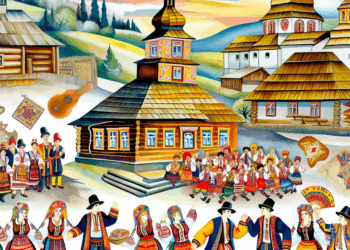Introduction
Bukovyna is a historical region at the crossroads of different cultures and peoples, now divided between Ukraine and Romania. Its history, permeated by many events and changes, reflects the diverse influences that different states and cultures have had on this region. In this article we will take a closer look at little-known but significant facts about the history of Bukovyna, covering the princely period, the Austrian Empire, the interwar years and the Soviet era.
Princely period
Founding and early history
At the turn of the IX-X centuries, the first suspensions of Slavic tribes began to form on the territory of modern Bukovina. However, historical documents begin to mention Bukovina as a part of the Galicia-Volyn principality in the XII-XIII centuries. It is known that during this period an important trade direction was formed on the eastern border of the Principality, which connected the Principality with Byzantium and the countries of Western Europe.
Fact: Prince Daniel of Galicia
Prince Daniel of Galicia, who ruled in the 13th century, is known not only for his military victories, but also for the fact that he strengthened the borders of the state, including the northern regions where modern Bukovina was located. His reign was an era of flourishing culture and trade. For example, the poet and literary figure Yuri Dolgoruky probably began his literary experiments at this time.
Archaeological findings
Among the archaeological finds in Bukovina, artefacts have been discovered that indicate the presence of fortresses and trade routes that connected Eastern Europe with Central Europe. These finds, such as ceramics and coins, indicate active trade and cultural exchange.
Times of the Austrian Empire
Annexation to Austria
In 1775, after the first Turkish war, Bukovina was annexed to the Austrian Empire. This event significantly changed its cultural and social landscape. The Austrian administration took a keen interest in the development of the region, which led to the construction of infrastructure and the consolidation of towns.
Fact: Long-awaited modernisation
At the end of the 18th and beginning of the 19th century, thanks to the Austrian reform, intensive modernisation began in Bukovina. In particular, the University of Chernovtsy was founded in 1875, which became one of the largest educational centres not only in Bukovina, but also in the whole of Eastern Europe. Languages such as German, Romanian and Ukrainian were taught at the university, which promoted cultural integration.
Cultural memory
At this time, there was also an active formation of national consciousness among different ethnic groups. An important aspect was the establishment of the Svytok Society, which aimed to preserve and develop Ukrainian culture, especially in the form of folklore and literature. Such activities contributed to the fact that representatives of different nations became more actively involved in the cultural life of the region.
Interwar years
Political instability
After World War I and the fall of the Austrian Empire, Bukovina became part of Romania. This period was marked by political instability and the search for a new identity. On 28 November 1918, the People’s Republic of Bukovina was proclaimed, but it lasted only a few months.
Fact: Intellectual achievements
Despite political instability, Bukovina became an important centre for different cultures and ideas. One of the most significant figures of this time was the Romanian writer Emil Ionescu, who worked extensively on issues of identity and cultural integration.
Education and culture
The interwar years were a time when culture flourished, with various theatres, art galleries and educational institutions. During this period, the “Skita Academy” was founded, which aimed to study and popularise the folk culture of Bukovina.
Soviet era
Influence of the Second World War
After World War II, Bukovina came under the control of the Soviet Union. This time was a turning point in the history of the region, leading to changes in politics, economy and society.
Fact: Industrialisation and changes in urban life
The 1940s and 1950s saw extensive industrialisation. An important milestone was the construction of the Chernivtsi Machine Works, which became one of the largest enterprises in the region and provided thousands of jobs. It also contributed to increased migration of people to urban areas, changing the socio-cultural landscape.
Cultural repression and identity preservation
Despite the repression and restriction of cultural life, many traditions and customs persisted, especially in the villages. This was an important time for the formation of ethnic identity, with an emphasis on language and folk traditions. Numerous folklore ensembles and art groups continued their activities, which contributed to the preservation of Bukovina’s unique cultural identity.
Conclusion
The history of Bukovina is not just a chronicle of events, but a narrative reflecting the interaction of different cultures and peoples. We have examined little-noticed facts related to each historical period that emphasise the importance of this region to the overall picture of Eastern European history. Despite unrest and change, the cultural heritage of Bukovina has been preserved and continues to influence modern life. A look into the past allows us to better understand the present and future of this unique region.








